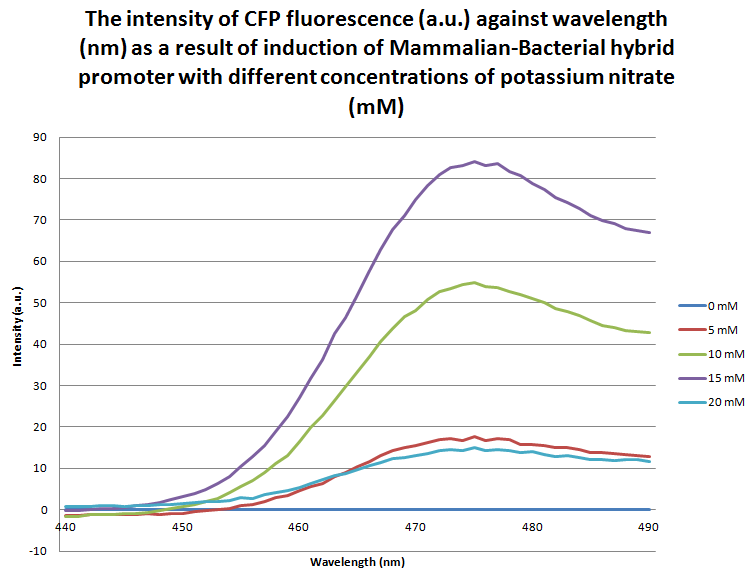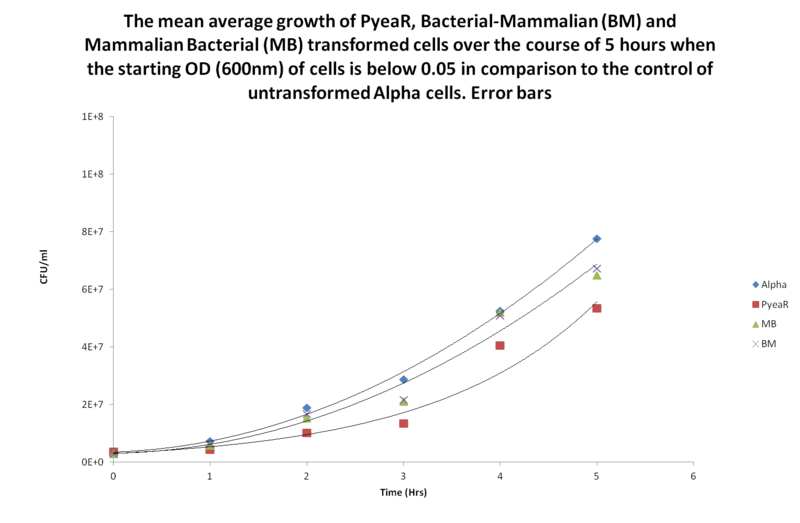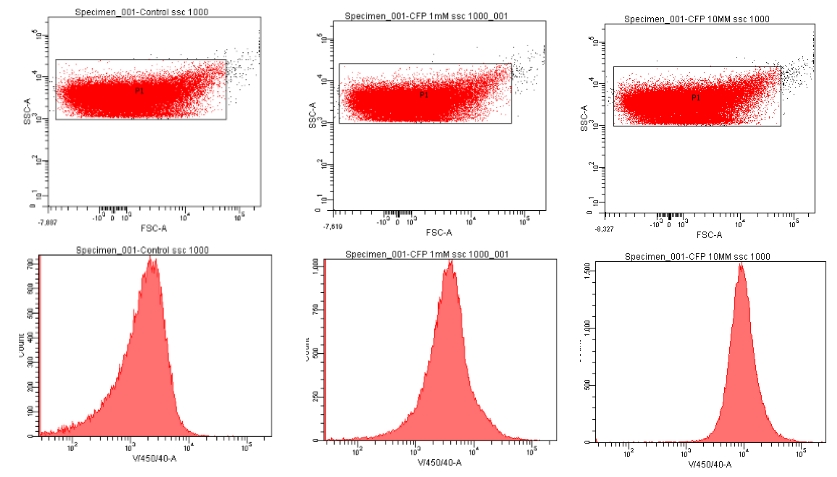Part:BBa_K774001:Experience
This experience page is provided so that any user may enter their experience using this part.
Please enter
how you used this part and how it worked out.
User Reviews
UNIQ4263b478a5914e3c-partinfo-00000000-QINU UNIQ4263b478a5914e3c-partinfo-00000001-QINU
NRP-UEA-Norwich 2012
The team (NRPUEA 2012) decided to develop the PyeaR biobrick (BBa_K216005) further by ligating it to its mammalian counterpart: CArG promoter sequence E9-ns2 (Scott, S.D. et al.2002). To provide additional restriction enzyme sites that may become useful during later cloning steps, BamHI, HindIII and NdeI were added between the 2 promoters. The genes were synthesised in two orientations, bacterial-mammalian (BBa_K774000) and mammalian-bacterial (BBa_K774001) as initially we were not sure what effect gene order would have on gene activity. The aim of this development was to increase the flexibility of the PyeaR promoter so that it can be used in both mammalian and bacterial systems. This is something that we thought was important as sensing nitric oxide in the human body has a wide range of therapeutic applications (please see the future applications section on our wiki).
The characterisation of our biobricks was carried out as follows:
-Growth studies of the PyeaR biobrick (BBa_K381001), the mammalian-bacterial (M-B) biobrick (BBa_K774001), and the bacterial-mammalian (B-M) biobrick (BBa_K774000).
-Measuring the fluorescence of the M-B biobrick ligated with Red Flourescent Protein (RFP) and enhanced Cyan Fluorescent Protein (eCFP), as well as the B-M biobrick ligated with RFP and CFP, in response to induction with different potassium nitrate concentrations.
-Measuring the number of cells which fluoresce in different potassium nitrate concentrations using flow cytometry.
Transfecting part BBa_K774006(mammalian-bacterial promoter ligated with eCFP) into mammalian cells to detect fluorescence and determine the functionality of the promoter.
Growth Studies
A comparison between the growth of E.coli cells, before and after transformation with the bacterial-mammalian promoter, as well as the mammalian-bacterial promoter (BBa_K774001) and PyeaR + GFP composite (BBa_K381001))
The study involved testing the affects of transforming E.coli with different promoters on its growth over time. The promoters E.coli was transformed with were PyeaR, M-B and B-M. These promoters all react to nitrogenous species. By running these growth studies together, we were able to obtain a direct comparison between all three of these promoters on the growth of E.coli. To see if the presence of novel promoters caused any significant changes in growth, the study was run alongside E.coli cells which had not been transformed with anything. For the rest of this brief report, untransformed cells will be referred to as Alpha cells and the other E.coli cells which have been transformed will be referred to as the promoter with which they were transformed with.
The E.coli cells used in all studies are Alpha select gold standard cells from Bioline, which have a hight transformation frequency.
To begin, a colony was inoculated into 5ml of LB media overnight, the cells spun down the following morning and diluted with fresh LB until an OD reading at 600nm of 0.2 ± 0.01 was obtained. Three repeats were made of each sample.
The study lasted for 12 hours. An OD reading at 600nm was taken once an hour. Between the hour, the cuvettes were put into a 37ᵒC incubator to encourage growth and to standardise measurements across all of the growth studies. To calculate the number of cells in each sample, a calibration curve was set up. This involved using cultures of the E.coli cells which had not been transformed. The E.coli cells were diluted with different volumes of LB and OD readings were taken at the same time as plating on Agar plates. After a day of growth, the numbers on these plates were counted and recorded. The CFU/ml was calculated. When the OD readings (x axis) and the CFU/ml (y axis) readings were plotted, the equation of the line of best fit, gives a conversion for the absorbance readings. This allowed us to measure the growth. This is demonstrated in figure 1.

Figure 1. Calibration curve to calculate the conversion factor between OD reading at 600nm and the number of colony forming units growing per ml (CFU/ml)
We found that there was a significant difference between Alpha cells and PyeaR cells. Initially, Alpha cells had a greater growth rate, but after the third hour into the study, the growth rate of PyeaR was faster than that of Alpha cells. The overall growth rate of PyeaR cells was significantly faster that Alpha cells (Levenes Test, F = 1.009 p = 0.372; T Test, t = 4.196, df = 4, p = 0.014).
Figure 2. Growth of PyeaR transformed E.coli cells relative to Alpha cells (untransformed cells). Error bars show the standard deviation between the three repeats. For clarity reasons, lines of best fit are not shown
The growth pattern and rate of E.coli cells with or without transformation with B-M and M-B show little difference. Any differences in growth rate were not significant. There was lots of overlap. As previously described, there was a significant difference between the growth rate of PyeaR and Alpha cells. There was also a significant difference between M-B/B-M and PyeaR cells. The statistical results can be seen in Table 1.

Figure 3.Growth over 12 hours of Alpha, M-B and B-M. Error bars and lines of best fit are not shown for clarity reasons.
Table 1. ANOVA readings of statistical differences between Alpha (1) PyeaR (2), MB (3) and BM (4).

From all the above graphs, it can be seen that with the starting concentration of cells as high as they are, the cultures are in exponential stage and do not undergo lag phase. A further growth study will be carried out on purely the lag phase with lower starting concentrations. As the starting absorbances here are approximately 0.2 at a wavelength of 600nm, the lag phase study will involve starting absorbances of 0.04 and lower.
A comparison between the growth of E.coli cells, before and after transformation with PyeaR + GFP (BBa_K381001) and B-M and M-B (in pSB1C3)- Lag Phase Study
Following the above study, we found that a lag phase only study needed to be carried out to see if there was a significant difference in the lag phase. Again the study protocol was the same except that the starting concentration absorbances at 600nm was lowered to <0.04. It was extremely difficult to keep the absorbances ranges within 0.005 so the range is actually 0.3±0.1. The graph below shows the mean average of all recorded data; using the data from the calibration curve, the absorbances were converted to colony forming units per ml (CFU/ml). The trend lines of alpha cells, B-M/M-B and PyeaR transformed cells are shown in order from highest to lowest trendlines. One single trendline was used to represent B-M and M-B because the trendlines were extremely similar. Using the initial concentrations of 0.3±0.1 it can be seen that there is little difference between the growth rates. Using statistical analysis, it was found that there was no significant difference between any of the transformed cells relative to Alpha cells or to each other (Anova, p > 0.05).
From this study we have found that changes in growth occur during exponential growth phase and not the lag growth phase.
Fluorescence studies
The hybrid promoter was ligated to two different reporters: enhanced Cyan Fluorescence Protein (eCFP)(BBa_K774004) and Red Fluorescent Protein (RFP) (BBa_K774005). The hybrid promoter was characterised by observing expression of flourescent protein, and found to have increased transcription in response to increasing concentrations of potassium nitrate.
This qualitative image (right) shows competent cells transformed with part: BBa K774004 and grown in media containing potassium nitrate (as a source of nitrates in order to induce promoter activity) at concentrations of 0 mM, 10 mM, 50 mM and 100 mM (from right to left). The E. coli was grown for 6 hours, added to eppendorf tubes, and spun down in a centrifuge in to produce a pellet. The four samples were then viewed under a UV box to assess for fluorescence; as the photograph to the right shows, the sample at 0 mM potassium nitrate did not fluoresce, however those at 10, 50 and 100 mM potassium nitrate did fluoresce. They also appeared to fluoresce at the same strength, suggesting that 10 mM was equal to or above the maximum sensitivity level of this part. The results below discuss whether this theory was correct.
NOTE: All data for the fluorometer has had the equivalent 0 mM reading subtracted from it in order to nulify the affects of light scattering due to cell debris

The graph above shows the flourescence measured from the expression of eCFP due to the response of the mammalian-bacterial promoter to different concentrations of potassium nitrate. The wavelength reading which corresponds to eCFP is between 440-500nm. The graph clearly demonstrates that between 0mN and 15mM there is a proportional relationship between fluorescence intensity and potassium nitrate concentration. It can be noted that at a 20mM concentration the intensity of fluorescence sharply decreases back down to the level of 5mM potassium nitate concentration. This may be due to the cell overexpressing eCFP up to the point at which the excess protein begins to form inclusion bodies which can no longer fluoresce; alternatively, this could be due the potassium nitrate concentration reaching the critical concentration at which it becomes toxic to the cell. This data differs to the readings taken from the bacterial-mammalian promoter ligated to eCFP, as well as the hybrid promoters to RFP, which may suggest there is a difference in the molecular mechanisms that these promoters function by; however at this point the change in intensity at 20mM is inconclusive and is an area which we would like to look into further.

The graph above shows the flourescence measured from the expression of RFP due to the response of the mammalian-bacterial promoter to different concentrations of potassium nitrate. The wavelength reading which corresponds to RFP is between 600-650nm. The graph clearly demonstrates that between 0mN and 15mM there is a proportional relationship between fluorescence intensity and potassium nitrate concentration. It has been found that for all biobricks apart from the mammalian-bacterial promoter ligated to eCFP at a 20mM concentration the intensity of fluorescence sharply decreases. This may be due to the cell overexpressing eCFP up to the point at which the excess protein begins to form inclusion bodies which can no longer fluoresce; alternatively, this could be due the potassium nitrate concentration reaching the critical concentration at which it becomes toxic to the cell. This data differs to the readings taken from the bacterial-mammalian ligated to eCFP, as well as the hybrid promoters to RFP, which may suggest there is a difference in the molecular mechanisms that these promoters function by; however at this point the change in intensity at 20mM is inconclusive and is an area which we would like to look into further.
Flow Cytometry
Flow cytometry was used with part BBa_K774006 to quantify the number of cells which fluoresced (eCFP) in response to induction by potassium nitrate.
Three tubes of media were inoculated with E. coli transformed by the M-B + eCFP biobrick (BBa_K774006). Each tube then had potassium nitrate added to it at different concentrations; 0 mM, 1 mM and 10 mM respectively. The E. coli were grown over night and then spun down, fixed in 4% PFA, spun down again and re-suspened in 500ul PBS. The samples were then analysed in an BA Aria II flow cytometer.
[http://2012.igem.org/Team:NRP-UEA-Norwich/Protocol Full Protocol]
Flow cytometry data for M-B eCFP transformed E. coli that were grown in either 0 mM, 1 mM or 10 mM potassium nitrate. Top row: Scatter plot of raw data and gating strategy utilised. Bottom row: eCFP Fluorescence profiles of samples.
As the graph indicates, the number of cells which fluoresce is proportional to the concentration of potassium nitrate that the cells are exposed to. Suggesting that our hybrid promoter is functional as expected.
Flexibility of the hybrid promoter: Mammalian Cells
The hybrid promoterswere created to increase the flexibility of chassis a promoter can be used in. To fully characterise the functionality of B-M and M-B, it was therefore important that the promoter could in fact work within mammalian and bacterial chassis. As the above studies show, M-B and B-M both function in bacterial cells.
To incorporate B-M and M-B into a mammalian system, transformations were not possible, instead a transfection was carried out. Unlike the growth studies, where growing colonies were sufficient to prove that the DNA within plasmids were incorporated, reporter proteins: CFP and RFP were attached to allow visual characterisation.
To transfect the cells we used lipid based transfection. To do this, media, transfection reagent, nitric oxide donor, DNA and cells were required. Below is the full list of reagents used:
. DMEM (Dulbecco’s Modified Eagle Medium) without serum to transfect and later treated with DMEM with serum and 10% Fetal Calf Serum. Cells are transfected without serum as serum interferes with the process but cells can die without serum so later is treated with serum.
. M-B +CFP was the DNA used. More than one sample was used. From nanodropping the concentrations of DNA were found to be both 500nm/µL. To transfect, 6.5 µL of DNA was used. The exact DNA we used was labelled MB2-C11a and MB2-C12a. The DNA was obtained from different colonies from the same plate.
. SNAP (S-Nitroso-N-Acetylpenicillamine) at a final concentration of 500µM. SNAP is the nitric oxide donor. Unlike bacterial cells where potassium nitrate could be used as a direct source. SNAP is metabolised by cells to produce NO which then induces the BioSensor.
. LipoD293 which is the transfection agent. This creates a membrane around the DNA which then binds to the mammalian cell and allows entrance of DNA into cell. This is much like endocytosis.
. The chassis used was MCF7 which is a human breast cancer cell line. The cells (30 µL) were seeded into a 6 channel slide at a concentration of 3 x 105 cells/ml.
In the process of transfection, LipoD293 was mixed with DNA at left for 15mins. Meanwhile, the media was removed from the cells and washed with serum free DMEM (100 µL). The transfection mixture was then added to the relevant channels on the slide. Below is how our channels were labelled.
For the full transfection protocol please click [http://2012.igem.org/Team:NRP-UEA-Norwich/Experiments here]
After the transfection, the media was changed to media containing serum and also SNAP was added. The cells were then viewed and the following images were obtained.
The images show what looks like exclusion bodies which have a greater concentration of fluorescent proteins than within cells. In the control without SNAP, there are none of these exclusion bodies found. In the control photo with SNAP and also the transfected cells without SNAP added, there are a few exclusion bodies. However, in the photos that showed transfected cells with SNAP added, there are a large number of these.
We do not know for certain what these may be, but a possibility is that the transfection was successful and the MB promoter does work. It may be that due to MB attachment to fluorescent proteins, the cells are producing exclusion bodies to rid the cells of these. In the control with SNAP, the cancer cells react to NO in the human body. These may be exclusion bodies formed from cells in general in reaction of NO. As to the transfected cell with exclusion bodies, there are very few of these. MB may be very sensitive to NO. As NO is naturally produced by cancer cells to induce angiogenesis, these may be for that reason.
Another possibility is that NO has induced the cells to apoptose and this has lead to vesicles forming containing the fluorescent proteins (Yu, et al., 1999). In non transfected cells, there is less fluorescent proteins compared to the transfected cells and hence there are more fluorescing vesicles.
Following transfection, to test the cytotoxicity of NO, the number of cells after addition of SNAP was calculated. The MCF7 cells were seeded into 6 well plates again at a concentration of 2.5 x 105 cells/ml. SNAP was then added at 500µM 2 days after plating. The cells were counted 24 hours after the addition of SNAP. For the full cell count protocol please click [http://2012.igem.org/Team:NRP-UEA-Norwich/Protocol#Cell_Counting here].
From previous studies such as that by Lala and Chakraborty, 2001 have shown that NO can lead to cytostasis and apoptosis. Our assay further confirmed this.
References
Lala, P.K. and Chakraborty, C. (2001) 'Role of nitricoxide in carcinogenesis and tumour progression', The Lancelet, 2;149–156.
Scott, S.D., Joiner, M.C. & Marples, B., 2002. Optimizing radiation-responsive gene promoters for radiogenetic cancer therapy. Gene therapy, 9(20), p.1396-402. Available at: http://www.ncbi.nlm.nih.gov/pubmed/12365005 [Accessed June 24, 2012].
Yu, W., Simmons-Menchaca, M., Gapor, A., Sanders, B.G. and Kline, K. (1999) 'Induction of Apoptosis in Human Breast Cancer Cells by Tocopherols and Tocotrienols', Nutrition and Cancer, 33;26-32.







